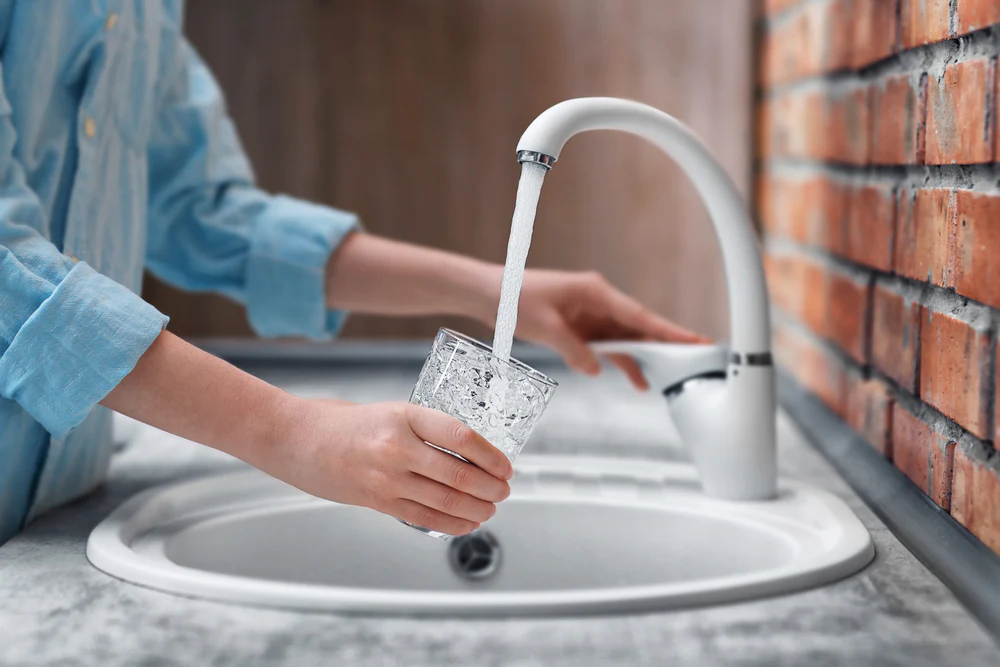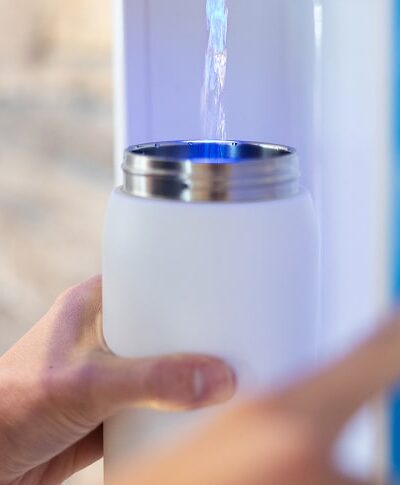Have you ever thought about how water makes it from its original source and to your faucet? Water goes through a filtering process long before it reaches the tap and is ready for use. This is necessary because surface water sources like lakes, rivers, and reservoirs contain impurities, bacteria, and other contaminants that can cause disease and leave an unpleasant taste and odor.
Groundwater is found in underground aquifers, which is obtained by wells pumping the water to the surface. Both surface water and groundwater are made available for public use, but groundwater is not always treated. Chemicals and pollutants lurk in the water from a number of sources. These may include fertilizers, pesticides, sewer overflows, and elements like lead, arsenic, and uranium.
Exactly how does a water filtration system work to extract these toxins and make safe drinking water? Public water systems follow five stages:
- Aeration – Adds air to the water while allowing gases to escape
- Coagulation – Suspends solid particles for easier removal from the water
- Sedimentation – Allows particles to settle to the bottom and the clear water on top is drained
- Filtration – Removes impurities that remain after the first filters are applied
- Disinfection – Frees the water of harmful organisms and bacteria
The water is strained from its original source to become potable. However, it’s not considered “filtered water” since a number of pollutants still remain. The recorded level is not the same for every municipality. Depending on the original water quality, certain regions may use other products to sanitize or further filter the water. These by-products also pollute the water even after it’s gone through the filtration process.
Drinking contaminated water can result in a multitude of health issues, including neurological disorders, problems with the stomach and intestines, as well as reproductive issues. Without the availability of filtered, purified water, it’s not as likely people will meet their daily intake.
Why Water Filtration is Necessary
There are no federal regulations to determine a standard of water quality across the board. However, the National Sanitation Foundation (NSF) has set minimum requirements for water intended for human consumption. Achieving minimum standards means less of these contaminants are found in the water but doesn’t indicate they’ve all been fully removed. It’s natural to assume the water that has gone through a typical water treatment still contains chemicals, bacteria, and other microorganisms.
The pipes the water runs through also make a difference in the purity of water that comes from the tap. Depending on the age of the pipe and the materials it’s made of, they can also leak toxins into the water. Old, lead pipes have been the central cause of many recent water emergencies across the U.S. where the city’s water supply is deemed undrinkable, which makes the importance of water filtration evident.
Due to the uncertainty of tap water quality, in addition to its poor taste and/or appearance, a majority of people choose to drink purified water only. It’s become the norm in many households. People either buy bottled water or rely on a water filtration unit. The availability of purified drinking water has also become more common in public areas like airports, gyms, and hotels. This is a convenient alternative to tap water and promotes a healthy lifestyle for people who want to stay hydrated without worrying about plastic waste.
FloWater’s advanced technology, specifically, transforms tap water by passing it through seven unique filters before it’s ready to drink. Each filter helps to purify the water, while also adding essential minerals and electrolytes. One of the filters is five times more effective than anything else available today. As a result of this high standard of water purification, people can enjoy cool, crisp water on demand.
Walking Through The Seven Stages of FloWater Filtration
FloWater’s purification process uses tap water as its source to run through a series of filters that remove up to 99% of all impurities. This leaves behind great tasting water that is free of chemicals, bacteria, and any other elements that are likely to still linger in tap water. With an advanced system like FloWater’s, you can be sure that you’re getting the best type of filtered water out there.
The first filter strains out rust, dust, dirt, and other suspended solids. When water flows from the treatment plant to the tap, there is still a chance for it to pick up sediment along the way. This filter captures any of these remaining substances and filters them out.
The second filter eliminates smaller particles, many of which create an unpleasant odor or taste. This includes chlorine, radon, and other heavy metals that affect the water’s purity level. Even when water goes through a city’s treatment process, many times there’s still a sour or chemical smell that makes the water undesirable to drink.
The final filter of purification is the advanced osmosis filter. At this stage, any remaining pollutants are removed by pushing the water through a semipermeable membrane. This includes contaminants such as bacteria, lead, pesticides, and other harmful agents that manage to make its way into water sources. This filter ensures nothing but pure water is left behind. After the water has made its way through the first stage, it’s time to improve the water’s quality and taste by sanitizing it and adding back valuable minerals.
During the sanitizing phase, activated oxygen is added to the water in small amounts. This naturally sanitizes the system and tanks versus using any chemical agents. Plus, it increases the level of oxygen in the water, which helps to improve the taste and benefits the body. Following the use of activated oxygen, the water goes through an alkaline filter. A proprietary blend of ten trace minerals is added to the water. This raises the pH level of the water to help neutralize the body’s acidity.
To round out the seven-step approach, there are two final filters. The electrolyte enhancement adds potassium, sodium, calcium, and magnesium, which aids the body by contributing to cell repair, bone strength, and the immune system. Such electrolytes are found in sports drinks and other healthy beverages. Unfortunately, those drinks are also laden with sugars and other additives that counteract the benefits of electrolytes.
Drinking filtered water for hydration is the healthiest way to go. However, not all methods are the same. Reverse osmosis, for example, filters tap water fully but also strips it of its natural electrolytes. Other solutions like water filtration pitchers or faucet attachments require constant filter replacement and may not capture as much sediment or impurities. FloWater achieves the highest level of purification and makes sure the water still maintains its natural benefits and tastes great.
Benefits of FloWater’s Water Treatment Technology
Through the power of FloWater’s Refill Station technology, it provides a solution for several challenges people face when looking for a reliable filtered water resource. In addition to the seven stages of filtration for premium purification, it also is designed to serve a high capacity of people. The tank holds seven gallons of chilled, purified water at all times and replenishes itself automatically every time water is dispensed.
Standing in line at the water fountain simply won’t cut it when you’re in a hurry. The Refill Station fills a 24-oz. bottle in a quick 9 seconds, which is 45 seconds faster than the average fountain or water cooler. This reduced time makes a difference at outdoor events, the gym, or the airport where crowds of people want to replenish their bottles at the same time. It cuts down on line time dramatically and allows everyone to fill up with ease and stay hydrated.
Unlike bottled water, the Refill Station leaves a smaller carbon footprint and doesn’t add any plastic to the environment. The station can fit in nearly any space and is designed with energy-efficient LED lights and sleep mode when it’s not in use. It’s a welcome sight for thirsty people and it helps brands and organizations promote a clean, eco-friendly way to get pure, freshwater without the need for maintenance or monitoring.
Know Where Your Water Comes From
How does a water filtration system work? The answer is: basically the same with a few exceptions. The foundation is similar regardless of the type of setup. Each is designed to trap and remove contaminants to provide drinkable water. The difference is in the technology and type of filters used. Some are more effective than others and provide a purer product.
There are several resources to find where your tap water is sourced from and the way it’s filtered. Water reports are public record and your local Consumer Confidence Report as issued by the U.S. Environmental Protection Agency can be found online. With a little research, you may be surprised to find out what is found in your public water system. It can change over time as pipes and water treatment systems age and processes become outdated.
Purified water has become the norm due to the decreased reliability of city tap water and the many benefits of water purification. There is a range of water filtration options, all varying in levels of purification, cost, and convenience. Choose an option that provides the best-tasting purified water on-demand to fulfill your filtered water needs. With FloWater, you know exactly how the crisp, pure water is achieved and will appreciate the high-quality that makes it stand out from the rest.
Sources:
https://www.cdc.gov/healthywater/drinking/public/water_treatment.html
https://www.epa.gov/sites/production/files/2016-03/documents/activity_grades_4-8_waterfiltration.pdf




